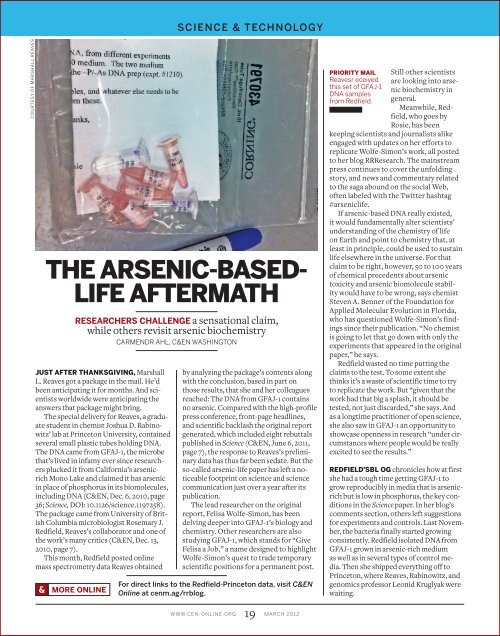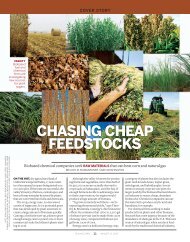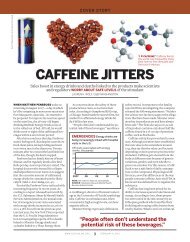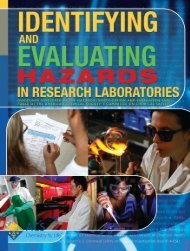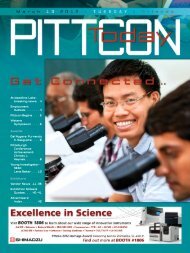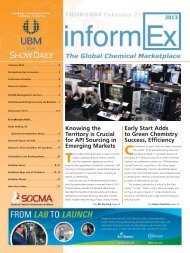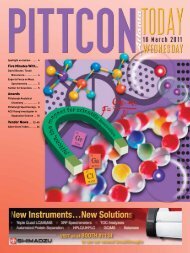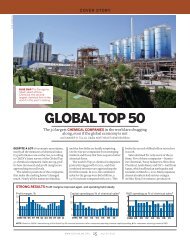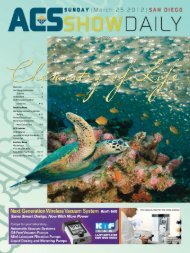“The industry has more than 20 years of manufacturingexperience with these types of molecules, and we’re seeingproducts that are extremely pure and really well characterized.”Another opti<strong>on</strong> for identifying proteinsis peptide mapping, which involves usinga protease enzyme to cleave an antibodyinto characteristic segments that can thenbe separated by gel electrophoresis or columnchromatography to yield a particularfingerprint.ON THE QUALITY fr<strong>on</strong>t, tests such asi<strong>on</strong>-exchange chromatography, isoelectric<str<strong>on</strong>g>focus</str<strong>on</strong>g>ing, or capillary electrophoresis willpick up variati<strong>on</strong>s in charge within theprotein structure that might indicate oxidati<strong>on</strong>,deamidati<strong>on</strong>, or protein clipping.In i<strong>on</strong>-exchange chromatography, howproteins interact with a charged stati<strong>on</strong>aryphase determines how quickly they elute.Isoelectric <str<strong>on</strong>g>focus</str<strong>on</strong>g>ing takes advantage of thefact that protein charges are a functi<strong>on</strong> ofpH and separates proteins using a gel witha pH gradient. Capillary electrophoresisseparates proteins by applying an electricfield to a capillary tube and can be d<strong>on</strong>eusing either free soluti<strong>on</strong> (capillary z<strong>on</strong>eelectrophoresis) or a gel (capillary gelelectrophoresis).For glycosylati<strong>on</strong>, manufacturers oftencreate a glycan map similar to a proteinmap. The antibody is enzymatically orchemically treated to remove the sugars,which are then given a fluorescent tag andseparated using high-performance or ultraperformanceliquid chromatography. Theglycans’ identities determine when theyelute from the column. Sialic acids, however,need a different approach. Because theyare destroyed by the standard acid treatmentto remove sugars, they are insteadremoved using mild acid and then analyzedby high-pH ani<strong>on</strong>-exchange chromatographywith electrochemical detecti<strong>on</strong>.To further pin down the specifics ofchemical modificati<strong>on</strong>s or changes inglycosylati<strong>on</strong> patterns, liquid chromatography-massspectrometry (LC/MS) has becomethe standard approach. An antibodyor its sugars are digested and separated asin other tests, but the resulting fragmentsare analyzed using mass spectrometry.LC/MS provides exact mass identificati<strong>on</strong>of the fragments but requires a highlyskilled operator, so it’s mostly used in developmentor problem solving, says TaegenClary, marketing manager for biopharmaceuticalsat Agilent .Nevertheless, LC/MS data have becomea necessary part of drug applicati<strong>on</strong> packagesto dem<strong>on</strong>strate that manufacturersunderstand what they’re seeing in theirquality-c<strong>on</strong>trol suite of assays. “I believethat if you d<strong>on</strong>’t supply some LC/MS datain a package, you’ll be asked for it because itis so comm<strong>on</strong> now,” Covance’s Kaiser says.To pick up aggregati<strong>on</strong>, <strong>on</strong>e approach issimply to look at a protein soluti<strong>on</strong>. If theaggregates are big enough, the soluti<strong>on</strong> willappear hazy rather than clear. To check forsmaller particles, size-exclusi<strong>on</strong> chromatography,also known as gel-filtrati<strong>on</strong> chromatography,is the standard method, withdetecti<strong>on</strong> by either ultraviolet light absorpti<strong>on</strong>or multiangle laser light scattering.Other techniques to look for aggregati<strong>on</strong>include light obscurati<strong>on</strong> and microflowimaging. Microflow imaging is amicroscopy technique that allows scientiststo distinguish, for example, whether aparticle is composed of protein or of silic<strong>on</strong>oil, which is used in drug formulati<strong>on</strong>s as alubricant for syringes. Those techniques aswell as analytical ultracentrifugati<strong>on</strong> mightbe used in development to help understandantibody aggregati<strong>on</strong> or in producti<strong>on</strong> todiagnose a problem, Kaiser says, but theprocess workhorse is high-throughputsize-exclusi<strong>on</strong> chromatography.ASIDE FROM THE QUALITY of the IgGmolecule, manufacturers must also keepan eye <strong>on</strong> the purity of the drug soluti<strong>on</strong>.Comm<strong>on</strong> impurities that manufacturerswatch for include residual DNA or otherproteins from the host cells, plus anyprotein A that might have carried throughpurificati<strong>on</strong>. Quantitative real-time polymerasechain reacti<strong>on</strong> (Q-PCR) methodsare used to amplify and quantify DNA,while ELISA targets protein A and host-cellproteins. In early development, manufacturersmight use cell-line-specific ELISAkits that c<strong>on</strong>tain antibodies to comm<strong>on</strong>cellular proteins. In late-stage development,however, companies often developprocess-specific assays by taking cells thatd<strong>on</strong>’t produce the therapeutic through thepurificati<strong>on</strong> process and using the outputto develop antibodies to whatever proteinsremain, Kaiser says.One additi<strong>on</strong>al area of MAb analysis isassays for potency. Potency tests, however,cannot readily be standardized across theclass. Different clinical acti<strong>on</strong>s by necessityrequire different potency tests, which areoften cell-based assays in which adding thedrug product elicits some kind of measurableresp<strong>on</strong>se.What’s being looked at is also a c<strong>on</strong>siderati<strong>on</strong>,whether it’s IgG proteins by themselves;antibody-drug c<strong>on</strong>jugates, whichtether a small-molecule drug to an IgG; orantibody fusi<strong>on</strong> proteins, which typicallycombine the IgG Fc comp<strong>on</strong>ent with anotherprotein. For antibody-drug c<strong>on</strong>jugates,most assays would be similar to those forunc<strong>on</strong>jugated IgGs, but scientists might paymore attenti<strong>on</strong> to a peptide mapping assayto make sure they know where and how successfullythe small molecule attached, Kaisersays. For fusi<strong>on</strong> proteins, manufacturerswould probably turn to the same analyticaltools as for intact IgGs, but they would haveto do more development work to optimizeassays and understand what the data show.Many of the analytical methods generallyused <strong>on</strong> MAbs, such as ELISA, chargeseparati<strong>on</strong> procedures, or size-exclusi<strong>on</strong>chromatography, are time-h<strong>on</strong>ored biochemicaltechniques, says Martina Bielefeld-Sevigny, vice president and generalmanager of drug discovery and researchreagents at PerkinElmer . The push now isto make those methods faster and easier,with better precisi<strong>on</strong>, accuracy, reproducibility,and sensitivity. In many cases, thatmeans going to microfluidic, lab-<strong>on</strong>-a-chipplatforms that use smaller amounts of materials,provide faster resp<strong>on</strong>se times, andenable high-throughput analysis.“I think that the m<strong>on</strong>ocl<strong>on</strong>al industry isa trailblazer,” USP’s Morris says. Pointingas an example to comm<strong>on</strong> use of capillarytechniques instead of plain gel electrophoresis,she adds, “I think they use fairly sophisticatedanalytical techniques comparedto plasma or peptide industry people.”That’s something that c<strong>on</strong>sumers canappreciate, for the extra assurance that adrug will work as advertised. ◾Reprinted from C&EN, Jan. 16, 2012WWW.CEN-ONLINE.ORG 18 MARCH 2012
SCIENCE & TECHNOLOGYCOURTESY OF MARSHALL REAVESTHE ARSENIC-BASED-LIFE AFTERMATHRESEARCHERS CHALLENGE a sensati<strong>on</strong>al claim,while others revisit arsenic biochemistryCARMEN DR AHL , C&EN WASHINGTONJUST AFTER THANKSGIVING, MarshallL. Reaves got a package in the mail. He’dbeen anticipating it for m<strong>on</strong>ths. And scientistsworldwide were anticipating theanswers that package might bring.The special delivery for Reaves, a graduatestudent in chemist Joshua D. Rabinowitz’ lab at Princet<strong>on</strong> University, c<strong>on</strong>tainedseveral small plastic tubes holding DNA.The DNA came from GFAJ-1, the microbethat’s lived in infamy ever since researchersplucked it from California’s arsenicrichM<strong>on</strong>o Lake and claimed it has arsenicin place of phosphorus in its biomolecules,including DNA ( C&EN, Dec. 6, 2010, page36 ; Science, DOI: 10.1126/science.1197258 ).The package came from University of BritishColumbia microbiologist Rosemary J.Redfield , Reaves’s collaborator and <strong>on</strong>e ofthe work’s many critics ( C&EN, Dec. 13,2010, page 7 ).This m<strong>on</strong>th, Redfield posted <strong>on</strong>linemass spectrometry data Reaves obtainedMORE ONLINEby analyzing the package’s c<strong>on</strong>tents al<strong>on</strong>gwith the c<strong>on</strong>clusi<strong>on</strong>, based in part <strong>on</strong>those results, that she and her colleaguesreached: The DNA from GFAJ-1 c<strong>on</strong>tainsno arsenic. Compared with the high-profilepress c<strong>on</strong>ference, fr<strong>on</strong>t-page headlines,and scientific backlash the original reportgenerated, which included eight rebuttalspublished in Science ( C&EN, June 6, 2011,page 7 ), the resp<strong>on</strong>se to Reaves’s preliminarydata has thus far been sedate. But theso-called arsenic-<strong>life</strong> paper has left a noticeablefootprint <strong>on</strong> science and sciencecommunicati<strong>on</strong> just over a year after itspublicati<strong>on</strong>.The lead researcher <strong>on</strong> the originalreport, Felisa Wolfe-Sim<strong>on</strong> , has beendelving deeper into GFAJ-1’s biology andchemistry. Other researchers are alsostudying GFAJ-1, which stands for “ GiveFelisa a Job ,” a name designed to highlightWolfe-Sim<strong>on</strong>’s quest to trade temporaryscientific positi<strong>on</strong>s for a permanent post.For direct links to the Redfield-Princet<strong>on</strong> data, visit C&ENOnline at cenm.ag/rrblog.PRIORITY MAILReaves r eceivedthis set of GFAJ-1DNA samplesfrom Redfield.Still other scientistsare looking into arsenicbiochemistry ingeneral.Meanwhile, Redfield,who goes byRosie, has beenkeeping scientists and journalists alikeengaged with updates <strong>on</strong> her efforts toreplicate Wolfe-Sim<strong>on</strong>’s work, all postedto her blog RRResearch . The mainstreampress c<strong>on</strong>tinues to cover the unfoldingstory, and news and commentary relatedto the saga abound <strong>on</strong> the social Web ,often labeled with the Twitter hashtag#arsenic<strong>life</strong>.If arsenic-based DNA really existed,it would fundamentally alter scientists’understanding of the chemistry of <strong>life</strong><strong>on</strong> Earth and point to chemistry that, atleast in principle, could be used to sustain<strong>life</strong> elsewhere in the universe. For thatclaim to be right, however, 50 to 100 yearsof chemical precedents about arsenictoxicity and arsenic biomolecule stabilitywould have to be wr<strong>on</strong>g, says chemistSteven A. Benner of the Foundati<strong>on</strong> forApplied Molecular Evoluti<strong>on</strong> in Florida,who has questi<strong>on</strong>ed Wolfe-Sim<strong>on</strong>’s findingssince their publicati<strong>on</strong>. “No chemistis going to let that go down with <strong>on</strong>ly theexperiments that appeared in the originalpaper,” he says.Redfield wasted no time putting theclaims to the test. To some extent shethinks it’s a waste of scientific time to tryto replicate the work. But “given that thework had that big a splash, it should betested, not just discarded,” she says. Andas a l<strong>on</strong>gtime practiti<strong>on</strong>er of open science,she also saw in GFAJ-1 an opportunity toshowcase openness in research “under circumstanceswhere people would be reallyexcited to see the results.”REDFIELD’S BL OG chr<strong>on</strong>icles how at firstshe had a tough time getting GFAJ-1 togrow reproducibly in media that is arsenicrichbut is low in phosphorus, the key c<strong>on</strong>diti<strong>on</strong>sin the Science paper. In her blog’scomments secti<strong>on</strong>, others left suggesti<strong>on</strong>sfor experiments and c<strong>on</strong>trols. Last November,the bacteria finally started growingc<strong>on</strong>sistently. Redfield isolated DNA fromGFAJ-1 grown in arsenic-rich mediumas well as in several types of c<strong>on</strong>trol media.Then she shipped everything off toPrincet<strong>on</strong>, where Reaves, Rabinowitz, andgenomics professor Le<strong>on</strong>id Kruglyak werewaiting.WWW.CEN-ONLINE.ORG 19 MARCH 2012


